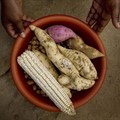The biggest single threat to food security in South Africa is the lack of subsistence farming, according to a panel of experts.
The experts from the Department of Agriculture, Land Reform and Rural Development, Agri SA and Statistics South Africa were speaking at a webinar on Food security and subsistence farming on Thursday.
The panel of experts have warned that more needs to be done to ensure that the current economic challenges in the country do not jeopardise the strides made in reducing food security challenges.
The Department of Agriculture, Land Reform and Rural Development smallholder development director, Dr Jemina Moeng said that the country is seeing a decline in the involvement of households in agriculture due to the climatic challenges people are exposed to.
"A lot of communities are reluctant to engage in agricultural production. Some are constrained yes, they do not have land and natural resources for production such as water.
"But a household garden in your backyard, even in a township or even in Sandton, will provide you with some vegetables. You do not necessarily need huge farms, but even at your backyard where we support household production at a garden level will definitely provide that household with food. So the biggest threat is people shying away from home food production and wanting to rely on food purchasing, which relies again on the amount of money you earn to be able to buy nutritious food," Moeng said.
Some of the factors that have had a detrimental effect on food security in the country include the recent Covid-19 pandemic, unrests, the Russia-Ukraine war and floods, among others.
"These challenges have caused a massive and rapid shock on the economy, exacerbating the already existing food insecurity challenges," Moeng said.
Mary-Jane Morifi 30 Apr 2020 The rapid assessment that was conducted by the department in collaboration with the Food Agriculture Organisation (FAO) in 2020 revealed that the pandemic had affected the entire food system domestically and globally, laying bare its fragility.
This included disruptions in farming operations, local markets especially for smallholder farmers, especially during the hard lockdown.
Moeng said her department was working towards combating threats to food security by implementing the six strategic objectives of the National Food and Nutrition Security Plan.
"Overall, the National Food and Nutrition Security Plan requires an average increase in funding of 13.7% for Food and Nutrition Security over the 5-year period. Robust strategies to mobilise funds for this sector are urgent and require strong Public-Private Partnerships," she said.
Statistics South Africa (Stats SA) said that South Africa is food secure at national level, however, the country is still food insecure at household level as not all households have access to adequate food.
In 2019, 17.3% of South Africans were estimated to be suffering from moderate to severe food insecurity, while 7.0% were estimated to be affected by severe food insecurity.
The provinces worst affected by moderate to severe food insecurity and severe food insecurity were the Northern Cape (28.8% and 15.4%) and North West (28.0% and 11.4%).
One out of five South Africans (23,6%) in September 2020 were affected by moderate to severe food insecurity, while almost 14.9% experienced severe food insecurity.
Scott Drimie and Michelle Eichinger 28 Jul 2022 Dr Nathaniel Dlamini, survey statistician at Stats SA, said that the female population is more likely to be affected by moderate to severe food insecurity than their male counterparts.
He added that Black Africans followed by coloureds are still more prone to be affected by moderate to severe and severe food insecurity than Indians/Asians and whites.
"Households involved in food production have been below 20% in the four years under review. Female-headed households are mostly producing their own food compared to male-headed households," Dlamini said.
Dlamini highlighted factors such as poverty, unemployment, income inequality, cost of living, unstable food production and the ability to produce food as some of the driving factors of food insecurity, among South African households.
Turning to the cost of living, Dlamini said that South Africa’s annual consumer price inflation was 7.4 % in June 2022, which is the highest since 2009.
He said that this means the food prices have been increasing and the most items that got very expensive in the past year include diesel, sunflower oil and petrol.
Stats SA has said that the involvement of households in agricultural activities for subsistence farming can play an important role in reducing the vulnerability to hunger of rural and urban food-insecure households.
The results have shown that out of 16.2 million households, about 2.5 million households (15.6%) were involved in agricultural activities in South Africa in 2017.



































